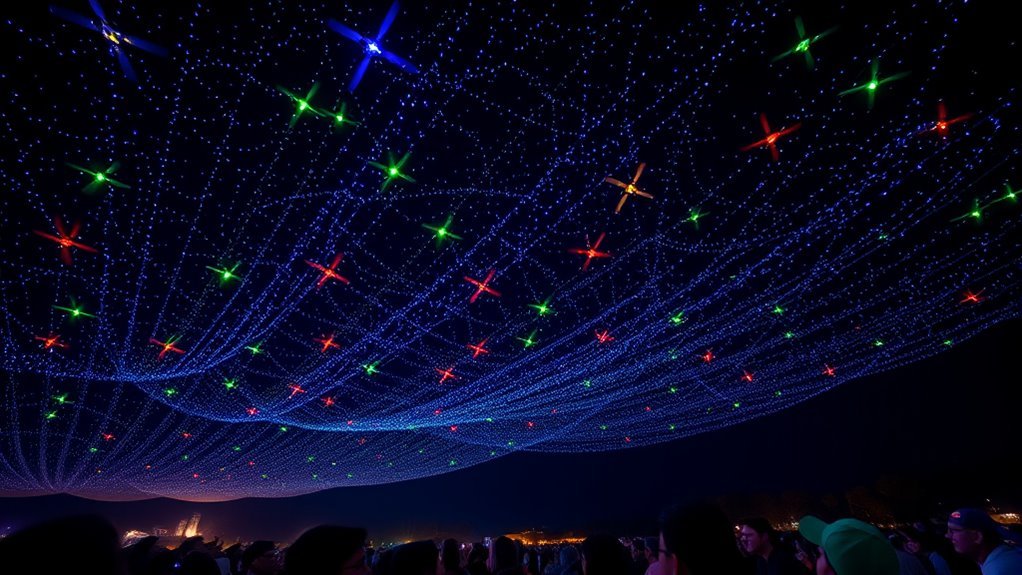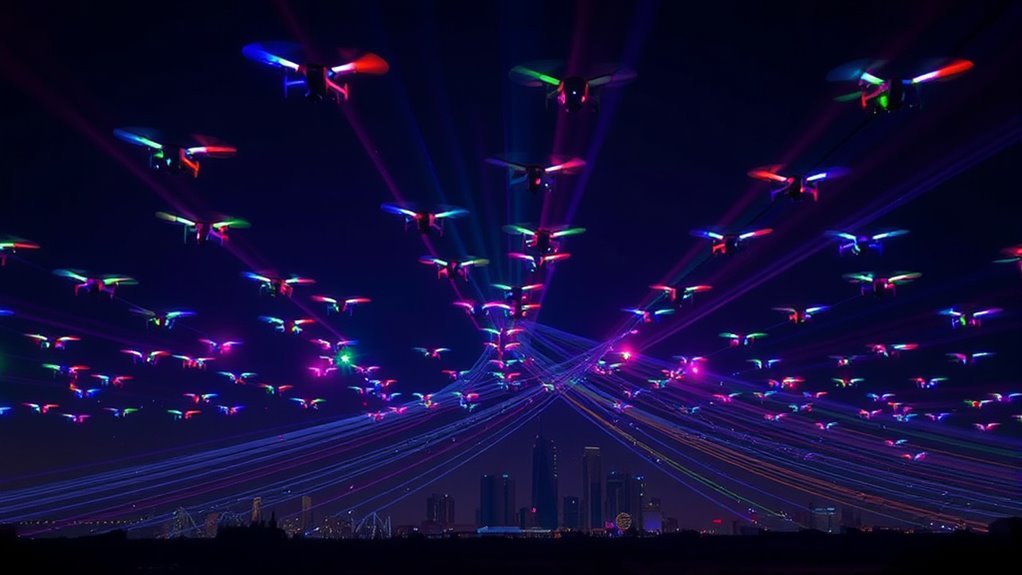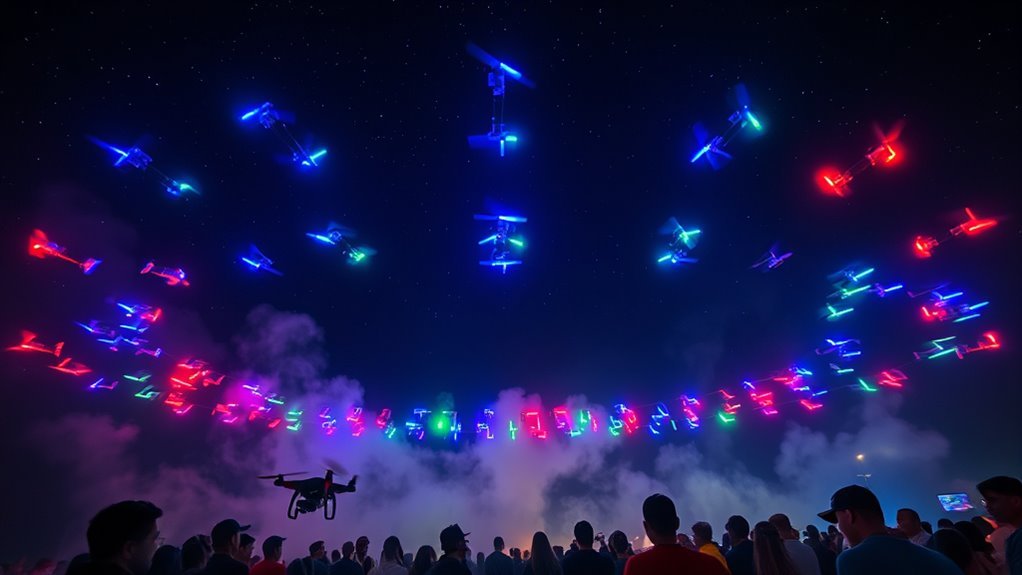You’ll see drone light shows work by coordinating GPS-equipped drones with vibrant LED arrays, controlled via complex algorithms that choreograph precise 3D flight paths and light sequences. These drones communicate in real-time using robust, low-latency protocols to maintain formation, avoid collisions, and synchronize movements flawlessly. Safety measures, power management, and operator training guarantee reliability while sophisticated software balances artistic design with technical constraints. Understanding this intricacy reveals how technology transforms the sky into a dynamic canvas of light.
Overview of Drone Light Show Technology

Although drone light shows may appear seamless and spontaneous, they rely on intricate technology combining precise hardware, sophisticated software, and real-time communication protocols to coordinate dozens or even hundreds of drones in synchronized flight patterns and light displays. You’ll find that drone technology integrates GPS modules, inertial measurement units, and LED light arrays, enabling accurate positioning and vivid visuals. The software component involves complex algorithms that calculate ideal flight paths and choreograph light sequences to guarantee safety and aesthetic appeal. Real-time communication systems maintain continuous data exchange between drones and ground stations, allowing dynamic adjustments to environmental conditions or potential anomalies. By understanding these core technological elements, you’re better equipped to appreciate how freedom in aerial artistry is achieved through meticulous engineering rather than random chance.
Types of Drones Used in Light Shows

Several distinct types of drones are employed in light shows, each selected for their specific capabilities and design features that optimize performance and safety. You’ll find that most rely on lightweight frames and advanced swarm technology, enabling coordinated, fluid movements. RGB lighting modules integrated into these drones allow vibrant, customizable color displays, essential for dynamic visuals. Here’s a breakdown of common drone types:Drone TypeKey Feature
Selecting the right drone type lets you maximize visual impact while maintaining precise control and safety in complex aerial choreography.
Designing the Visual Patterns and Animations

Choosing the right drones sets the foundation, but crafting the visual patterns and animations determines the show’s artistic and technical success. You’ll rely heavily on advanced animation software to design formations that maximize visual aesthetics while respecting drone capabilities. This software enables you to experiment with 3D models, color shifts, and timing sequences, ensuring each frame is both enchanting and feasible. Precision is essential: your patterns must balance complexity with clarity, avoiding visual clutter that can confuse the audience. You get to freely explore creative concepts, yet must ground them in technical constraints like drone spacing and light intensity. Ultimately, designing these animations is a meticulous process blending artistic vision with analytical rigor to produce a seamless, awe-inspiring experience.
Programming Flight Paths and Synchronization
Programming flight paths and synchronization demands meticulous calculation and exact timing to guarantee each drone moves seamlessly within the formation. You rely on advanced flight path algorithms that compute precise coordinates, velocities, and altitudes, ensuring drones avoid collisions while executing complex maneuvers. Synchronization techniques then align the timing of each drone’s movements and light activation to produce a fluid, unified display.
Key steps include:
- Defining waypoints and trajectories for each drone based on the desired visual pattern.
- Applying synchronization techniques to harmonize drone positions and lighting effects with the show’s music or cues.
- Simulating and refining flight path algorithms to optimize efficiency and safety before deployment.
Communication Systems Between Drones
While precise flight paths are essential, they rely heavily on robust communication systems between drones to maintain coordination throughout the show. You depend on efficient communication protocols to enable real-time data transmission, ensuring that each drone adjusts its position instantly. These protocols balance latency, bandwidth, and reliability, allowing the swarm to operate freely yet harmoniously.
| Protocol Type | Latency | Use Case |
|---|---|---|
| Wi-Fi | Low (ms range) | High data transfer |
| Mesh Networks | Moderate | Decentralized control |
| RF Communication | Very Low | Long-range commands |
Safety Measures and Regulations
To operate a drone light show legally, you’ll need to secure airspace authorization, guaranteeing your flight path doesn’t interfere with other aerial activities. Collision avoidance systems are critical, as they automatically prevent drones from crashing into each other or obstacles during complex formations. Additionally, operator training requirements guarantee pilots have the technical skills to manage these systems and respond to emergencies effectively.
Airspace Authorization Process
Because drone light shows operate within controlled airspace, securing proper authorization is critical to guarantee safety and regulatory compliance. You must navigate complex airspace regulations and authorization procedures to ascertain your event is legally permitted. Here’s what you need to focus on:
- Identify Controlled Airspace: Determine the exact airspace class and restrictions relevant to your show location.
- Submit Authorization Requests: File detailed flight plans and risk assessments with aviation authorities well in advance.
- Coordinate with Authorities: Maintain communication with air traffic control and comply with any operational limitations imposed.
Collision Avoidance Systems
Securing airspace authorization sets the stage for safely conducting drone light shows, but managing in-flight safety requires additional layers of protection. You’ll rely heavily on collision detection technology embedded within autonomous navigation systems to prevent mid-air collisions. These systems continuously monitor spatial positioning, using sensors and algorithms to detect proximity threats in real time. When a potential collision is identified, autonomous navigation systems autonomously adjust flight paths without operator intervention, ensuring seamless coordination among dozens or hundreds of drones. This technology grants you the freedom to design complex aerial choreographies while maintaining rigorous safety standards. By integrating precise collision avoidance protocols, drone light shows achieve a balance between artistic expression and operational security, minimizing risk and maximizing reliability in dynamic airspace environments.
Operator Training Requirements
Effective operator training is critical for guaranteeing safety and regulatory compliance in drone light shows. You need well-structured training programs that enhance operator skills to handle complex flight patterns and emergency scenarios. These programs focus on technical proficiency and adherence to aviation regulations, giving you the freedom to execute creative displays without compromising safety.
Key components of operator training programs include:
- Comprehensive Flight Simulation: Develops precise control and situational awareness.
- Regulatory Knowledge: Guarantees understanding of airspace rules and safety protocols.
- Emergency Response Drills: Prepares you for unexpected malfunctions or environmental challenges.
Power Sources and Battery Management
While drone light shows rely heavily on intricate choreography and precise navigation, their success ultimately hinges on reliable power sources and efficient battery management. You’ll find that lithium-polymer (LiPo) batteries dominate due to their high energy density and lightweight design, enabling extended flight times without compromising maneuverability. Effective power management systems optimize energy efficiency by regulating discharge rates and monitoring voltage in real time, ensuring consistent drone performance throughout the show. Charging stations play a critical role, allowing rapid, safe recharging and turnaround between performances. By integrating smart battery management protocols, you gain the freedom to push drones to their operational limits while minimizing downtime. Understanding these components is essential to maintaining uninterrupted flight operations and achieving flawless light displays.
Challenges in Coordinating Large Drone Fleets
When managing large drone fleets, you need to guarantee each unit follows a precise flight path to avoid collisions and maintain formation integrity. Real-time communication systems are critical for synchronizing movements and adapting to dynamic conditions instantly. Without flawless coordination, the entire light show risks disruption or failure.
Precise Flight Path Planning
Coordinating a large fleet of drones requires meticulous flight path planning to prevent collisions and maintain synchronization. You rely on advanced algorithms to generate precise trajectories ensuring every drone follows a unique, conflict-free path. Trajectory optimization is critical, balancing efficiency with safety to maximize freedom of movement while adhering to spatial constraints. When planning, you must:
- Calculate 3D coordinates and velocity profiles for each drone to maintain formation integrity.
- Predict and adjust for environmental factors like wind, minimizing deviations.
- Incorporate fail-safes that automatically reroute drones if unexpected obstacles arise.
Real-Time Communication Systems
Because real-time communication forms the backbone of synchronized drone operations, you must address significant challenges in maintaining reliable, low-latency data exchange across large fleets. Coordinating hundreds or thousands of drones requires robust communication protocols that minimize packet loss and latency while ensuring scalability. You’ll need to implement mesh or star network topologies optimized for real-time data transmission. Interference, signal attenuation, and bandwidth constraints complicate maintaining continuous links, demanding adaptive frequency hopping and error correction. You must also manage synchronization to prevent collision and maintain formation integrity. Balancing these factors means selecting protocols that support rapid command dissemination and feedback loops without overwhelming network capacity. Fundamentally, effective real-time communication systems enable your drone fleet to operate fluidly, granting the creative freedom to execute complex aerial choreography seamlessly.
Future Innovations in Drone Light Displays
As drone technology advances, you’ll see significant improvements in the precision and complexity of light displays. Future technology will enable drones to execute intricate choreography with enhanced spatial accuracy, allowing for more dynamic and immersive visual experiences. You’ll benefit from creative collaborations between software developers, artists, and engineers that push the boundaries of what’s possible. Key innovations to watch include:
- AI-Driven Flight Paths: Algorithms optimizing drone trajectories in real-time for fluid, collision-free movements.
- Advanced Light Modulation: Use of micro-LEDs and programmable color spectra for richer, more vibrant displays.
- Swarm Autonomy: Enhanced decentralized control systems granting drones greater independence and adaptability during performances.
These advancements offer you unprecedented freedom to design and enjoy complex, seamless aerial shows that redefine entertainment.

